
Tested: The truth behind the MacBook Pro's 'terrible' battery life
 Image: Adam Patrick Murray
Image: Adam Patrick Murray
Read professional reviews of Apple’s new MacBook Pro lineup, and you’ll come away thinking the new laptops have great battery life.
Dive into a customer forum, though, and the upshot will be exactly the opposite: The new MacBook Pros have “piss poor” battery life.
That characterization came from user yillbs on MacRumors.com. “I don’t think anyone can convince me that this thing isn’t just flat out the worst battery life ever on a MacBook,” yillbs wrote, clearly frustrated. “I’ve been defending it like mad, but at this point… how can you? 4.42 hours is just bad.”
User Happypuppy was anything but. “Not happy with the battery either. I was editing my MacBook review video last night and at 6:28 p.m. it was at 100 percent,” Happypuppy wrote. “At 8:52 p.m. it was down to about 42 percent.”
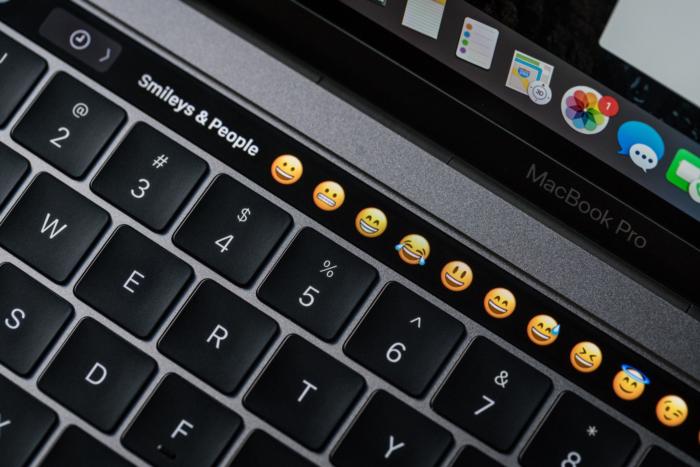 Adam Patrick Murray
Adam Patrick MurrayComplaints about poor battery life on the new MacBook Pro lineup have been piling up—despite the laptops’ high marks for battery life from professional reviewers.
Contrast those writeups with Macworld’s review, which said: “Battery life is also solid, with both models lasting a full day of heavy use, with multiple apps open, dozens of Safari tabs, streaming music to Spotify, and occasionally indulging in some video viewing with Sierra’s picture-in-picture feature.”
Macworld isn’t alone. From Laptopmag to The Verge and Notebookcheck.net, the vast majority of reviewers have lauded the MacBook Pros for good battery life.
My own tests agreed. I’m no fan of the MacBook Pro’s butterfly-switch keyboard, nor its lack of USB Type A ports, but one thing I do know is it has relatively good battery life. When I tested both a non-Touch Bar 13-inch MacBook Pro and the base 15-inch MacBook Pro some months ago, I was able to coax about nine hours of 4K video playback from each at 255 nits of brightness.
A search for the truth
The truth about the MacBook Pro’s battery life had to be somewhere in this mess of conflicting results. I returned to the MacBook Pro 15 I’d tested before to put it through multiple run-down scenarios, charging and discharging the MacBook Pro 15 under different loads over the course of many days.
This particular MacBook Pro 15 is the baseline model with a Core i7-6700HQ, Radeon Pro 450, 16GB of LPDDR3/2133 RAM, and 256GB of flash storage. The OS I used in the majority of these tests was the latest public one available when I started my testing: macOS Sierra 10.12.2. I disabled automatic screen dimming and manually calibrated brightness using our Minolta photometer for each of the brightness settings I used.
You’d typically run these tests multiple times to calculate an average to reduce variability. Given the considerable time it takes to perform individual run-down tests, I went with a more casual single-run scenario.
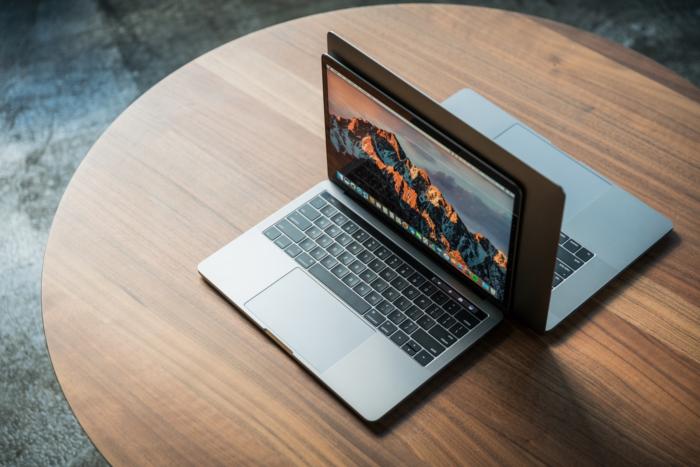 Adam Patrick Murray
Adam Patrick MurrayThe MacBook Pro 15 with discrete graphics has indeed suffered from a software problem that chews up the battery.
Video playback is still great
For the first test, I ran the open-source 4K movie Tears of Steel. The actual video player you use can have a huge impact on battery life (you can read more on this topic here), so I opted to use Apple’s QuickTime player. Apple’s official video run-down test uses iTunes, but I’ve never figured out how the company is able to get the video to loop for its tests.
The video was looped with the Wi-Fi switched off and audio on. Rather than the laptop’s speakers, I used earbuds to (theoretically) reduce the power drain from driving the larger speakers. The brightness settings I used were at a fairly dim 100 nits, a fairly bright 257 nits (which is a good setting for an office or home in the daytime), and finally, the laptop’s maximum brightness setting of 500 nits.
The MacBook Pro 15 has pretty stellar life playing video. Set to 257 nits, we’re seeing just about eight hours of battery life. Even more impressive to me is that at the blazing 500-nit setting, you can still get six hours of run time. Considering the 2880-by-1800 native resolution and brightness of the panel, that’s actually pretty nice.
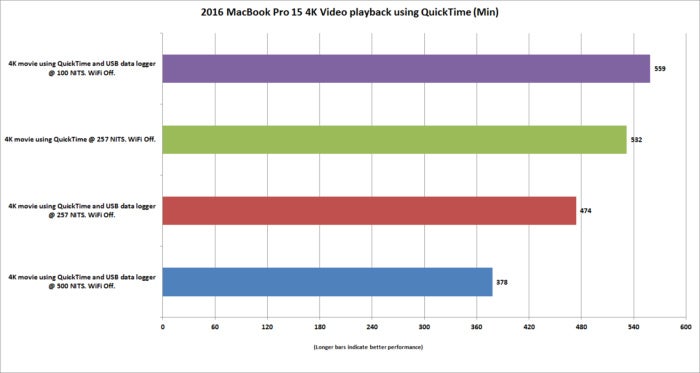 IDG
IDGYou can expect from 6 to 10 hours of battery life playing 4K video, depending on the brightness of the screen.
There’s one more result on the chart to be aware of, and that’s the battery life when none of the laptop’s USB-C ports are being used. For all the other tests, I used a self-powered device that logs the voltage of the USB port. This lets us know when the laptop is on, and when it finally dies.
This device works because on older MacBook Pros and most other laptops, the USB Type A ports are run on chips that are usually powered on at all times. The MacBook Pro, however, uses Thunderbolt 3 controllers. With Thunderbolt 3, the chip appears to conserve power by switching off when not being used.
With our USB device in place, however, the Thunderbolt 3 chip appears to stay awake. The laptop itself did not log any power being consumed by the Thunderbolt port, but the results pretty much match the consumption I’ve seen on another couple of laptops, so I think there’s still a small cost in power.
The upshot: If you run a USB device on your MacBook Pro, you’ll take a small hit. If you refrain from doing that, then you’ll probably get slightly longer battery life.
Streaming video playback
Most video today is watched online, not offline. Using a brightness setting of 257 nits, I flipped on the Wi-Fi and measured how long it took to run down the MacBook Pro 15 on YouTube and Netflix. For YouTube, I picked a 24-hour Nyan Cat video that’s pretty low-res. I don’t get Nyan Cat, but apparently it’s a thing. It’s also a 24-hour video, so there wasn’t a chance it would stop in the middle of the night and invalidate my test.
Rather than pick a video on Netflix and try to rewind it every few hours, or try to binge-watch a show (which can be unreliable, as the video will occasionally stop streaming), I decided to use Netflix’s internal test video called Example 8 hour 23.976. I intentionally forced the video bit rate to the 4870 option. Audio was on for both, and I used a set of earbuds.
The results look good. The YouTube video ran for just under nine hours, while the Netflix video was just short of eight hours.
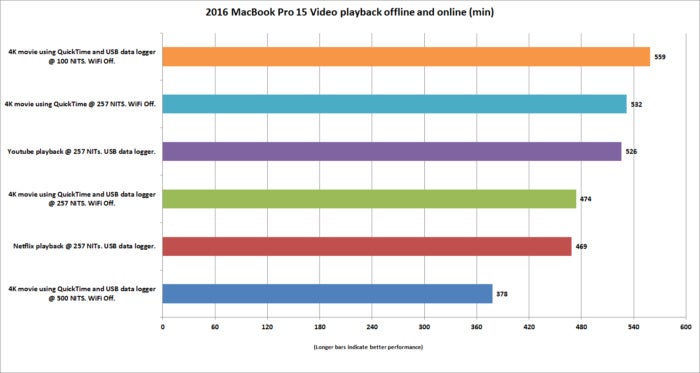 IDG
IDGNetflix and YouTube streaming also yielded fairly good battery runtime on the new MacBook Pro 15.
Battery life under hard use: This is the tricky part
When you’re looking at this category of laptop, however, you shouldn’t expect people to limit their chores to light duty. It is a “pro” laptop, right? One thing I don’t think people understand is just how much of a penalty you pay when you push the GPU or CPU very hard.
To find out, I ran two tests. The first used the game Tomb Raider. I set the game for 1680×1050 resolution on the medium setting and ran the game’s built-in benchmark. Once the benchmark is finished, it continues to loop a 3D scene. I then unplugged the MacBook Pro 15 and let it run down to zero. This particular test is mostly a load on the GPU, but the CPU is working as well.
After recharging the laptop, I ran the test using Prime95, which is a pure CPU test. I used the Torture Test Blended mode and manually recorded when the laptop died.
Both tasks emptied the battery in just over 80 minutes. You can see how drastic the battery situation gets depending on how hard you push it. Drive it hard, and you’ll be lucky to get an hour or so out of it.
The point of these two tests is to address the people who say they “just did a little video editing” or some other intensive tasks for a “short time” before the battery ran down. Look at this chart and then think about your mix of work. A short time is all you should really expect if the task really pushes that CPU or GPU. On intensive tasks, the only way to get longer life is use a larger battery (more on that below.)
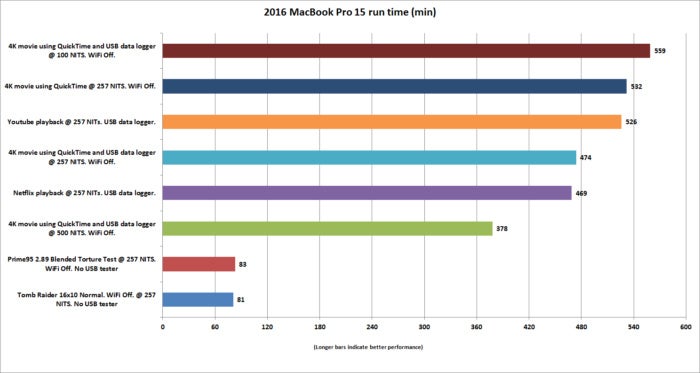 IDG
IDGPush the GPU or CPU hard on the new MacBook Pro 15, and battery life will plummet.
There was, indeed, a bug. Read on to learn all about it.
There was, indeed, a bug
In looking at other battery run-down scenarios, I ran smack into a problem that’s likely at fault for many of the confusing battery life issues with the laptop, at least in macOS Sierra 10.12.2. On occasion, the laptop’s discrete GPU would just get stuck on and consume power even when it wasn’t used. Others had reported this too, but you’d really have to stumble onto it.
I was able to reproduce the issue in Safari by opening Google Maps, which would cause the laptop to switch over to the GPU for the WebGL workload. Opening additional browser tabs and then closing the Google Maps tab would, on occasion, leave the GPU consuming up to 10 watts of power while doing absolutely nothing.
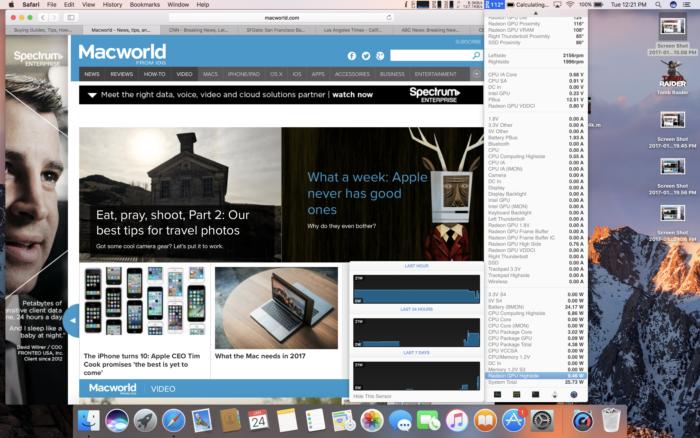 IDG
IDGYou can see from this screenshot of the 2016 MacBook Pro 15 running Sierra 10.12.2 that the discrete GPU is consuming power even though the laptop has switched over to integrated graphics. That power drain would occur sometimes even after we quit Safari.
Even though the MacBook Pro 15 had switched back to Intel graphics, the Radeon Pro would just suck up power. How much? I found after triggering this bug that I could kill the laptop in just 206 minutes, or a scant three and a half hours of basically idling with Safari open, Wi-Fi on, and eight websites loaded.
This isn’t just a blame-discrete-graphics moment, either. I performed an idle test with Safari open to Google Maps. This switched on the Radeon Pro, which would consume about 5 watts just idling. With Wi-Fi on and the screen set to 257 nits—but essentially nothing happening—the battery stretched out to 1,135 minutes, or just shy of 19 hours.
This particular power drain isn’t completely the fault of the Radeon Pro. I suspect this to be the cause of many of the problems people are reporting.
 IDG
IDGApple’s 10.12.3 update to Sierra seems to have fixed the Radeon Pro from getting stuck on and using power even when nothing was happening.
What Apple fixed
The Sierra 10.12.3 update seems to have fixed the problem. Apple officially says the update “improves automatic graphics switching on the MacBook Pro 15,” and it does.
I could no longer get the Radeon Pro to consume phantom power. It’s as though Apple basically increased the graphics load requirement before firing up the power-hungry GPU. Google Maps and even more intensive WebGL tasks would no longer fire up the Radeon Pro at all. Most of the time you really don’t need it, as the Intel IGP is generally more than enough for web graphics.
I tested the updated OS running the same task that earlier gave me the horrible 206 minutes of battery life under Sierra 10.12.2. The battery life stretched out to 631 minutes under Sierra 10.12.3.
Interestingly, I never initiated the developer mode that Consumer Reports did when it initially held back on recommending the MacBook Pros to consumers. Consumer Reports’ tests found the battery life to be all over the map and attributed it to the developer mode it used in its browser test.
Once Apple patched the OS, Consumer Reports reversed its decision. Those fixes eventually went into the final release of Sierra 10.12.3, but it’s not clear to me what exactly happened in the situation that Consumer Reports ran into.
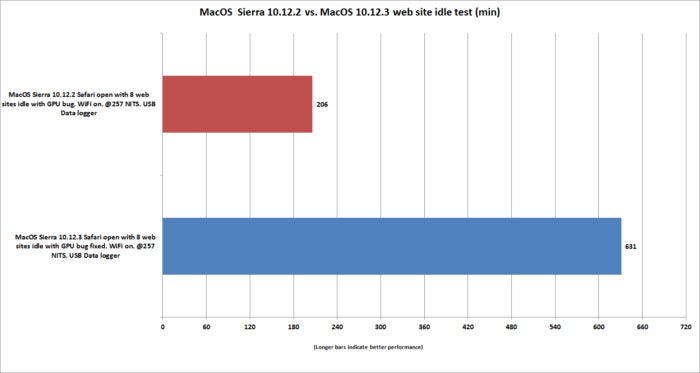 IDG
IDGAn apparent bug in MacOS 10.12.2 and Safari would cause the Radeon Pro to consume energy even when it wasn’t being used. Apple appears to have fixed it in 10.12.3.
The smaller battery is clearly a limitation
If you think the battery life situation (at least on the MacBook Pro 15) is solved, there’s something else you should consider that can’t be fixed in software: the smaller battery.
Prior to the 2016 MacBook Pro 15, Apple shoved giant 99.5-watt-hour batteries into the MacBook Pro 15 series. With the thinner, lighter late-2016 model, Apple reduced the size of the battery by almost 25 percent to 76 watt-hours. This downsizing has a real cost. While the new MacBook Pro 15 is impressively efficient, sometimes efficiency isn’t enough.
If you think of cars, many factors contribute to the driving range between refueling, including the size of the gas tank, how aerodynamic the car is, and how efficient the engine and transmission are. On a laptop, the battery capacity, measured in watt-hours, is akin to the fuel tank. The power efficiency of the CPU, GPU, and components could be the engine and transmission efficiency. The amount of power the display uses could be the aerodynamics.
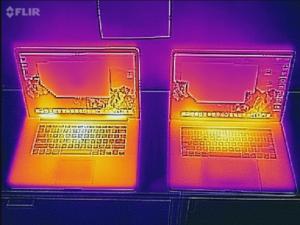 IDG
IDGSeen through our FLIR thermal viewer, you can see the older 2013 MacBook Pro 15 (left) or the new 2016 MacBook Pro 15 (right) getting toasty when their CPUs are pushed hard.
As you saw from the previous numbers, the general efficiency of the display, CPU, GPU, and other system components on the 2016 MacBook Pro 15 are actually quite good.
It also compares quite favorably with older systems. To illustrate this, I grabbed a MacBook Pro 15 circa 2013. This laptop was built with a quad-core Ivy Bridge Core i7-3635QM and GeForce GT 650M graphics. It has 8GB of RAM and a 256GB SSD. This older MacBook Pro 15 also features just about the largest permanent laptop battery allowed by law onto a plane—99.5 watt hours. Despite its age, the battery itself was in good shape, with fewer than 10 discharge cycles on it and a health report of 99 percent.
A clean install of macOS Sierra 10.12.1 was used before testing. First came our 4K video run test at a brightness of 255 nits, Wi-Fi off, and our USB data logger in place. I should note that this model doesn’t have a Thunderbolt 3 chip, so there’s no power cost from having a USB device plugged in.
Even with its larger 99.5-watt-hour battery, the 2013 MacBook Pro 15 tapped out at only 330 minutes, which is well south of 6 hours. Compare that to the 2016 MacBook Pro, which, with its 25-percent-smaller battery, made it all the way to 474 minutes, or almost two hours more run time.
During video playback, both used the integrated Intel graphics and were mostly idling. The 2013 MacBook Pro 15 consumed about 18 watts, while the 2016 MacBook Pro 15 used about 13 watts.
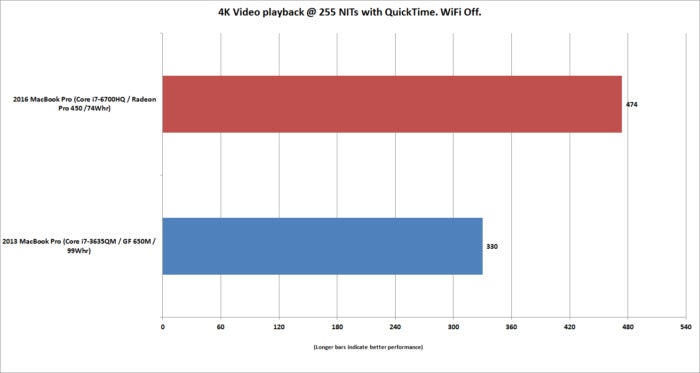 IDG
IDGEven with a battery that is 25 percent larger, the older 2013 MacBook Pro 15 can’t beat the efficiency of the new 2015 MacBook Pro 15 model.
The other factor in fuel mileage is how hard you drive it. No matter how efficient the engine is or how aerodynamic the car, sometimes having a larger fuel tank matters more.
To prove this point, I tasked the 2013 MacBook Pro with the same Prime95 torture test as the 2016 model. This test, if you recall, basically pushes all cores of the CPU as hard as possible. In car terms, it would be like flooring it fully loaded with passengers and luggage while going up a mountain. You’re burning a lot of fuel.
The older 2013 MacBook Pro has that in spades with its 99.5-watt-hour battery. It was able to run flat-out for 97 minutes before dying. The newer 2016 MacBook Pro, as efficient as it is, can’t push the CPU that hard for that long before emptying its 74-watt-hour battery at 83 minutes.
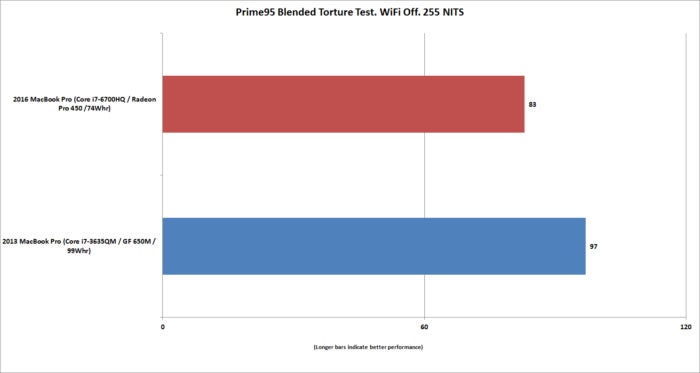 IDG
IDGWhen you drive both laptop CPUs really hard, the efficiency of the newer 2016 MacBook Pro 15 can’t make up for the giant battery in the older MacBook Pro 15 model.
Increasing the battery capacity by 25 percent may not yield exactly 25 percent more battery life, but it would certainly last longer than it does now under heavy-duty loads. Those who actually use their MacBook Pro 15 in heavier tasks on battery may indeed experience shorter run times than with older models, especially if their point of reference is a more recent and more efficient Haswell- or Broadwell-based model.
And the tests say: Your mileage will vary
After all that battery testing, there are several takeaways:
The 2016 MacBook Pro 15 did indeed have a bug that would sometimes cut short battery life. Apple appears to have corrected the problem.I found that plugging the MacBook Pro 15 into an external monitor engaged the discrete GPU full-time at a cost of 9 watts. While it’s unlikely you’d be at a desk using an external monitor without being plugged into AC, if you do, expect poor battery life.The newer MacBook Pro 15’s 500-nit screen is brighter. If you’re comparing it to an older MacBook Pro 15, use the same brightness settings to make the comparison fair.As reviewers originally found, the MacBook Pro 15 still has pretty decent life for a notebook in its class. Eight to nine hours of video playback at 257 nits on a quad-core equipped laptop with discrete graphics is very respectable. Comparable Windows laptops I’ve seen with quad-core CPUs, 4K screens, and discrete graphics generally offer worse battery life. Apple may have compromised too much by putting a smaller battery in the MacBook Pro 15. It’s clear from the testing on the older Ivy Bridge MacBook Pro 15 and the newest MacBook Pro 15 that the 76-watt-hour battery can yield shorter battery life on heavier loads. How much battery life should you expect? Well, as the tests here show, depending on what you’re doing, the answer is anywhere from an hour and a half to 18 hours. Not satisfied with that answer? Unfortunately, it’s the only correct one, as battery life on any laptop will vary depending on what you do.